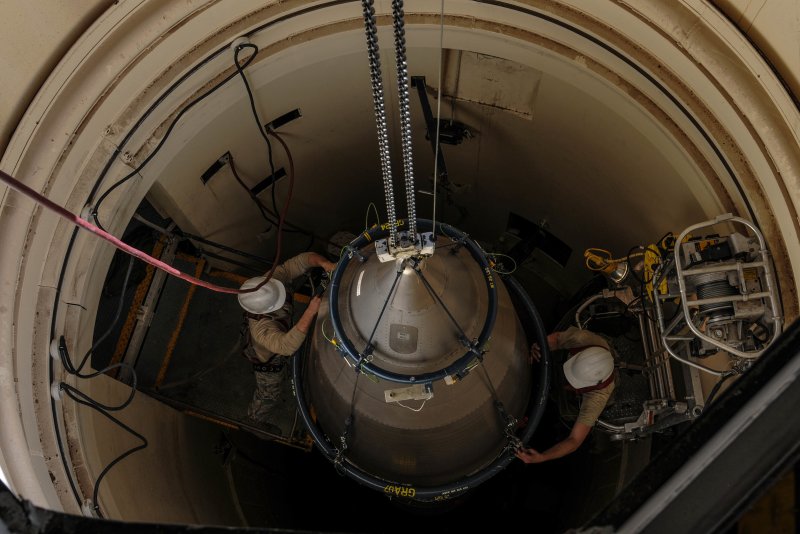Airmen from the 90th Missile Maintenance Squadron prepare a reentry system for removal from a launch facility in February 2018 in the F. E. Warren Air Force Base missile complex. The 90th MMXS is the only squadron on F. E. Warren allowed to transport warheads from the missile complex back to base. Photo by Airman 1st Class Braydon Williams/U.S. Air Force
Sept. 30 (UPI) -- Engineers at MIT have developed a new nuclear warhead verification test using neutron beams. The new technology could help weapons inspectors do their job.
Currently, parties to nuclear disarmament treaties don't actually destroy warheads. Nations don't want regulators to be privy to nuclear engineering secrets.
Instead of destroying warheads, Russia and the United States disarm nuclear missile and bomb deliver systems. To demonstrate their compliance with the START Treaty, for example, the U.S. military sawed the wings off B-52 bombers and piled them in the desert for Russia to see.
As a result, stockpiles of idle nuclear weapons remain vulnerable to attack, theft or accidental detonation.
"There's a real need to preempt these kinds of dangerous scenarios and go after these stockpiles," Areg Danagoulian, an MIT nuclear scientist, told MIT News. "And that really means a verified dismantlement of the weapons themselves."
Danagoulian and his colleagues, building off of earlier computer simulations, developed and tested a new method for establishing basic facts about warheads slated for dismantlement.
The method utilizes a neutron beam. For their test, researchers sent the beam horizontally through a warhead proxy. After passing through the target, the beam passes through a lithium filter, which works to scramble the information embedded in the altered beam. Finally, the beam is sent to a glass detector, which captures the data recorded by the beam.
The data can be analyzed to confirm the beam passed through an actual warhead. For the test, scientists used molybdenum and tungsten for their warhead proxy. The two metals are similar to plutonium.
The test can identify the specific isotope of the target element, which could allow inspectors to confirm the identity of a warhead before it's disassembled.
"At the low energy range, the neutrons' interactions are extremely isotope-specific," Danagoulian said. "So you do a measurement where you have an isotopic tag, a signal which itself embeds information about the isotopes and the geometry. But you do an additional step which physically encrypts it."
At the same time, the physical data scrambling built into the test method allows specific details about the makeup of the weapon -- engineering secrets -- to remain undetected.
"You could, in principle, do it with computers, but computers are unreliable," Danagoulian said. "They can be hacked, while the laws of physics are immutable."
The test could also help inspectors compare the makeup of one nuclear warhead to others, allowing them to confirm that a stockpile of warheads for disarmament are all authentic weapons -- not one real weapon and a bunch of counterfeits.
Scientists previously demonstrated the method's potential using computer models, but performing a physical test could help pave the way for the adoption of the test method by world governments.
"Simulations capture the physics, but they don't capture system instabilities," Danagoulian said. "Experiments capture the whole world."
Moving forward, the researchers said they will work to develop a portable version of their technology -- described Monday in the journal Nature Communications -- to be tested at actual weapons sites.















